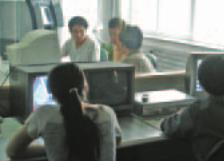The rapid technological transformation underway in China has extended into the banking world, resulting in increasing demand for automatic teller machines (ATMs). The number of ATMs in China has increased from approximately 12,000 in 1996 to more than 105,000 in 2006.
The country is also ranked first in the world for the growth of its bank card business: by the end of June 2004, it had issued 714 million bank cards and bank card-based trade had grown 60 percent over the previous year. In 2006, 960 million cards were issued. To ensure that consumers would find ATMs useful and usable, a collaborative research project was established between NCR’s Advanced Technology and Research Group in Scotland and the Sino European Usability Center in Dalian. The project was conducted mainly in Dalian, an economic center in Northeast China with a population of six million, and partly in Shanghai. The research explored the role of the ATM in the lives of Chinese consumers. It also explored usability issues with a technology, which, though commonplace in Western society, is relatively new to the Chinese market. The objectives of this research were to identify factors that might affect requirements for ATM design, problems or issues with current ATMs in China, and appropriate ways in which to increase ATM adoption.
To collect this information, we used a broad range of research methods, from focus groups designed to help us understand barriers to acceptance, to iterative prototyping and evaluation.
Focus Groups
The focus groups covered both regular ATM users and non-users in Shanghai and Dalian. Discussion in the focus groups covered topics such as good and bad experiences with ATMs, issues with ATMs, and advantages and disadvantages. We also addressed reasons for non-use, first-time experiences with ATMs, desired locations, and opinions on the look and feel of ATMs.
Surveys
Focus groups are useful for identifying potential issues, but they do not give a sense of how representative any ideas and opinions may be. Thus, surveys were used to consolidate the ideas extracted from the focus groups and determine whether these thoughts and experiences were commonplace.
The surveys were carried out in the city center shopping area of Dalian. One hundred people were interviewed: sixty users and forty non-users. The users were interviewed face-to-face after completing a transaction at an ATM and non-users were approached on the streets.


Expert Evaluation and User Testing
Three usability experts evaluated the ATM and the application to predict possible areas of difficulty or confusion for the users. This expert evaluation was followed by user testing—twenty users and ten non-users ran through a series of representative transactions using a prototype ATM with its typical software interface. The tasks were videotaped and times and errors were recorded. As a result of the findings, the software interface was then redesigned and re-evaluated.


The Results: Banking Culture in China
There is a Chinese saying, “You can have everything, but you can’t have debt.” Credit cards, loans, and mortgages are not very common. Chinese people generally have much less debt than Westerners, although the younger generation is beginning to take out mortgages and assume other debts. According to NCR China, 85 percent of personal accounts are for savings. Further, for personal banking, there is usually only one account per person and only one account is associated with each bank card.
Bank cards are used at the bank teller as well as at ATMs. Branch banking is common in China and, as in other countries, branches are viewed as being too busy and keeping inconvenient service hours. People use the branches to receive their salaries, manage their savings accounts, and pay bills. Bills can only be paid at the bank and at the service providers. Recently, more services, such as mortgages, are starting to appear at branches.
Current ATM Use in China
ATM use in China is relatively infrequent. Just over half the participants said they used the ATM once a week, while the rest used it less. One of the key uses of the ATM was to withdraw a person’s salary from the account provided by the employer and place it in his or her own account. People feel that they cannot easily transfer money between two accounts. Therefore, large withdrawals are made at the same time every month, and ATMs empty quickly. A typical withdrawal limit (approximately 1500 Renminbi or RMB per transaction—about $190 US or €150) means multiple transactions are required to withdraw some employees’ entire salaries, but there is also a daily limit. These limits were implemented to reduce fraud, but the participants said they believed it was also a way of making large transactions less convenient and thereby keeping machines stocked.
Perceptions of ATMs
The main advantages of ATMs were cited as, “Not having to carry around too much cash.”; “Convenience,” and ”Giving the same service to all users.” Also, there is a common perception that ATMs are a sign of modernity.
Consistent with more established ATM markets, many people say they don’t care about the shape and color of ATMs, only their functionality. However, young people may be an exception as they seem to be more interested in design. The young generation of ATM users said they would like the ATM box to be colorful, distinctive, and cartoon-like.
A few participants expressed concerns that might affect ATM use in China. Some, such as privacy and security, are universal. However, others—card retention and the availability of the ATM—seem specific to China.
People are not keen to leave an ATM that has seized their card in case the card is returned or the account is still active and other people can access it. Banks retain cards for a number of reasons; because the card is damaged or for a different bank, or the person entered the wrong PIN. However, many banks are relaxing the criteria under which the machines seize a card, especially cards from other banks. Even if the occurrence of card retention is decreasing, the perception of a potential problem may inhibit some consumers from using ATMs.
Privacy and safety appear to be major concerns of Chinese consumers. Approximately 30 percent cite “fear of having their PIN stolen” as a concern. At the time our study was carried out, there was some media coverage on fraud at ATMs, so this could be a source of the concern. In terms of privacy, there are sometimes yellow lines on the pavement to denote where people should stand in the queue, but these are sometimes ignored. There is a perception that white-collar workers are more respectful of privacy than blue-collar workers.
Over half the participants in this study cited issues with non-functioning or malfunctioning machines. However, only 12 percent of users reported that they or their friends or family had actually experienced malfunctioning ATMs. People also reported trouble using ATMs in different cities and from different banks. Approximately one-third of participants complained about the lack of available denominations and withdrawal limits being too low. A small percentage of participants believed that ATMs sometimes cause mistakes in their accounts.
Usability Issues
As ATMs become commonplace, users become habituated to the interaction and pay little attention to the actual instructions on the screen. It is difficult to test the usability of the ATM application when participants know what they should be doing anyway. In China, however, we were able to identify some basic issues with the usability of the application.
From a physical perspective, the type of card reader on the prototype caused problem. This card reader did not capture and hold the card. Instead, that the user had to insert and then remove the card quickly. The card is read when it is removed. However, users believed it was read when it was inserted. The instructions on the screen asked the users to “Dip the card,” a term they did not understand, and did not ask them to remove their cards. No participant could complete the interaction until this element had been explained. The physical function keys at the side of the screen also had to be explained, since many participants assumed that the interface was a touch screen and all interaction would be with the screen.
A number of screen instructions and banking terms also caused problems for some users. These issues were addressed by using paper prototyping techniques to work out how best to redesign these areas of difficulty.
Desired Changes
In terms of visual design, people said they would like a common but unique look (like mailboxes) for all ATMs so that they cannot be missed. Sometimes the ATM is overlooked by the user because it is not identifiable as such. The participants also said they would like improvements to safety and privacy. The most commonly requested solution to the perceived privacy problem was that the ATM be housed in a telephone box-like booth. Also, for safety, half the participants said they would be interested in using a fingerprint rather than a PIN at the ATM.
In terms of hardware functionality, participants said they would like screens that ensured visibility in sunlight and minimized parallax—in other words, displacement of the button from its label due to user viewing angle. They also said that they would prefer touchscreens, as long as they are sensitive and accurate enough.
Users suggested a direct phone connection to the bank for support and help when a card is retained. They also said they would like security cameras and prefer to have instructions on how to insert the card on the card itself rather than on the machine or the screen.
In terms of software functionality and services, Chinese users say they would like to add these options: bill payment—being able to view and print account records or update a passbook; notification of inter-city and inter-bank charges in advance; and receipts for charges when they are on business.
Non-users are Different
One point of this study was to understand the characteristics of non-users and their reasons for non-use. Although they didn’t use them at ATMs, 60 percent of non-users did have bankcards. They are generally older than the users and many of them are elderly. Some had no interest in, or need to use, ATMs, whereas others were interested but were too worried about “first time” use and the potential risks in using a bank card.
Conclusion
Chinese users perceive that ATMs are convenient and modern and perhaps an inevitable part of life. However, our research highlighted a pattern of behavior that did not match our expected use of ATMs—withdrawing a full month’s salary rather than making small regular withdrawals.
Many of the issues raised during this research are similar to issues raised in more mature markets. However, the usability testing highlighted a particularly problematic area that would have caused real problems if the product had been released into the field. This was the need to “dip” the card; while “dip” readers remove the fear of losing the card to the machine, the inadequate instructions meant that the users would have been unable to start the interaction.
Among the users who adopted the new technology enthusiastically, their acceptance even carried over into new technologies such as biometrics; for example, fingerprint recognition was cited as a solution to safety and privacy concerns.
Future work will investigate users and non-users outside of the larger cities and the Eastern coastal area where technology use is high.
[bluebox]
Sidebar
China’s population is 1.3 billion.
By December 2006, 123 million Chinese people had gone online, making China the second largest Internet user market in the world, after the U.S.A. The current number of Internet users is only around 10 percent of mainland China’s total population. In comparison, the country has 437 million mobile phone users. Coastal cities have quickly adopted new technologies, but interior provinces and the state sector appear to lag behind economically and technologically.
For more on banking in China, see the Matthews Funds’ AsiaNow, Issue 2006.
[/bluebox]
